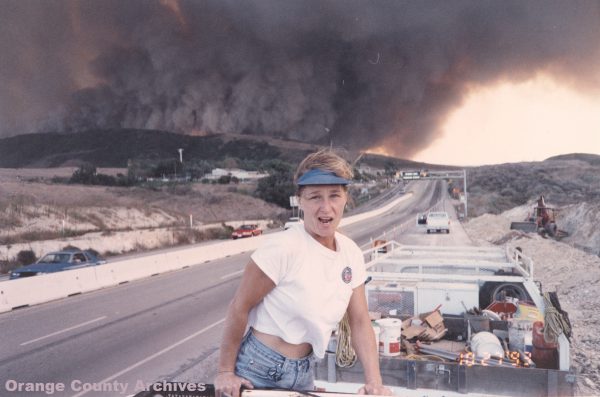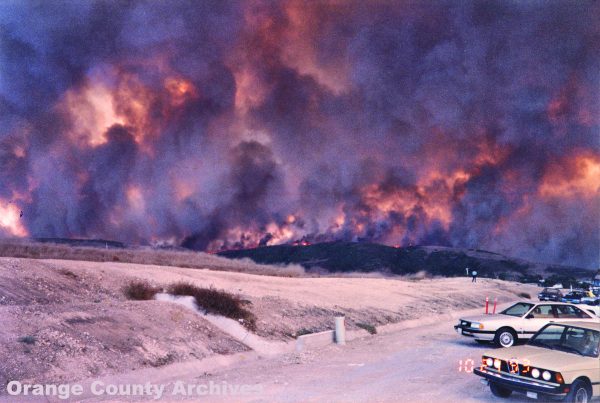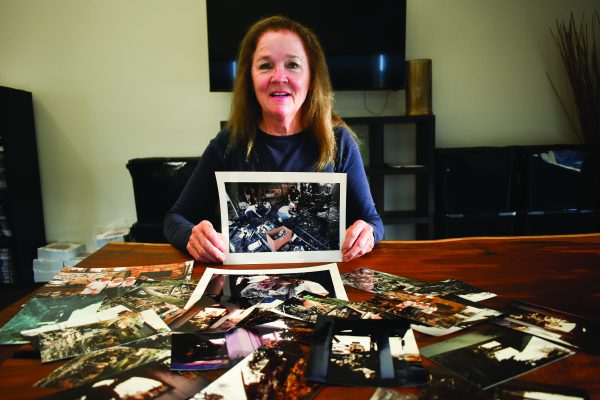Thirty years ago, the Laguna sun transformed into a muted brown. The sky glowed with an amber haze. Laguna Beach was on fire.
“It looked like a Salvador Dali painting,” resident P.J. Duke said. “It didn’t seem like real life. The world looked so different.”
At 11:50 a.m., Oct. 27, 1993, fire authorities received five 911 calls that Laguna Canyon Road was on fire. The blaze would turn into the most destructive wildfire on record in Orange County.

The National Fire Protection Association ranked the ‘93 fire 15th out of the 25 largest fire losses in United States history. The conflagration engulfed almost 16,000 acres, destroyed or severely damaged more than 400 residences and generated $528 million in damage.
“When my then husband and I tried to get back into town, traffic was crawling,” said Duke, who was at work in Huntington Beach when she heard the news over the radio. “People had personal belongings piled up on top of their cars. Tons of emergency vehicles. Flashing lights everywhere. There were people on horses or leading horses through downtown – it was a surreal scene.”
Duke lived at Canyon Acres, near the Sawdust Festival grounds along Laguna Canyon Road. When she finally got home to grab the lock box, she was met by small fire tornados – funnel clouds of swirling and hopping fire, thick, grey smoke and floating embers.

“There were ashes the size of business cards floating down from the sky,” Duke recalled. “By the time we left, I could see the fire coming over the ridge toward our house, and it was looking pretty obvious it would burn down.”
The fire took off when embers from its origin point in Laguna Canyon jumped a firebreak into Laguna Beach and Emerald Bay, the top of which burned at a rate of 100 acres a minute, according to the Orange County Fire Authority’s 50-page 1993 Firestorm Report. The blaze exploded across Laguna Canyon Road in six areas, bounding up the slope with flames reaching 200 feet. The fire burned 1.25 miles of vegetation in just 17 minutes before reaching Canyon Acres, where Duke lived at the time.
If it was just her home burning down, Duke said processing the loss might have been easier. However, learning an anonymous arsonist was responsible, left Duke and other Lagunans affected by the devastation with complicated feelings of anger, shock and helplessness.
Sheila Patterson, who lost her Canyon View home during the fire, said she and other fire survivors found their footing thanks to support meetings organized by the local Presbyterian Church.

“We had a fire marshal come and talk to us, a tax expert, an insurance adjuster; they provided a ton of helpful resources for us,” she recounted. “We desperately needed that expertise.”
Fire survivors were issued an ID card for generous discounts at local retail shops like IC London and Hobie Surf Shop. Restaurants and the local food pantry gave out free food. Mossimo, a popular fashion brand at the time, donated piles of designer clothes for those in need.
“We all bonded in the fire survivor group,” said Duke, who met Patterson at a meeting. “It’s hard to describe what it’s like to lose all your material possessions. Right away, I was grateful that no one died that day. I kept saying to myself, ‘It’s just stuff.’ The stuff that matters can’t be burned. It was a serious kick in the pants in terms of accelerating who you really are.”
1993 to now
The 1993 Fire was the first real significant firestorm in Laguna’s history. The fire science behind how to mitigate and defend homes, the defensible space, the fuel modification, etc., existed, but not to the scale it does at present day. The wave of wildfires that occurred that week in Orange County prompted new state legislation on fire prevention, the forming of a Wildland-Urban Interface Taskforce and modifications in firefighter training.
Laguna Beach Emergency Operations Coordinator Brendan Manning said learning from California’s historic fires has allowed authorities to better create safe zones and mitigate fires. However, over the past 30 years, developments in technology has been vital in fire prevention.
“At the time, the Orange County Fire Authority didn’t have any operational helicopters, and there were very few in the area,” Manning said. “In reality, between helicopters and fixed-wing aircraft, it’s a very different response than it was.”
Along with the use of aircraft to fight fires, Laguna Beach Fire Chief Niko King said cameras have also been critical. If a fire starts, by human or natural causes, authorities are notified immediately, usually before the public calls 911.
“We have cameras everywhere now,” King said. “They’re monitored 24/7 and have technology that will notice any kind of heat or smoke signatures. It’s a lot easier to get the point of origin recognized. And if there isn’t a camera directed to that space, there are traffic cameras, and/or everyone has a cell phone now, which makes it easier to transfer information than back in the early 90s.”
Preparing for emergencies
Spearheaded 12 years ago by Mayor Pro Tem Sue Kempf, the Emergency and Disaster Preparedness Committee (EDPC) is a citizen advisory group dedicated to public safety and another resource implemented to tackle fire prevention.
“As an advocacy group, their job is to take the existing plans and put them into motion. The group also creates new reports and plans to look at our public safety in a broader sense,” said Manning, who is EDPC’s head liaison.
EDPC created the Wildfire Mitigation and Fire Safety Report, made final in 2019, which Manning considers one of their biggest accomplishments.
“The committee’s biggest strength was pulling out the report every single month and saying to city council, ‘What are we doing with action item four? Why aren’t we moving forward with action item six? What should we be funding?’ In my experience, it’s easy enough to create reports, and so often, we look at lessons learned, we create a report, and it sits idle. With the Wildfire Mitigation and Fire Safety Report, it didn’t. EDPC spends a lot of time advocating and pushing for items in the report to be developed.”
Manning said the EDPC is also focused on Laguna’s estimated evacuation time. He said the EDPC report critically examines the city’s evacuation routes and looks at ways to streamline the process.
“It’s a scary number to say, ‘In a normal circumstance, it will take four hours to evacuate,’ but now, after EDPC has advocated to have that report completed, we have a tangible document to say, ‘we need to be doing X, Y and Z so we can lower that number,’” Manning said.
The City of Laguna Beach prioritizes its communication channels to reduce fire risk and spread awareness to its residents. Along with social media posts, Nixle alerts and community wildlife preparedness meetings, the city also installed speakers and sirens throughout Laguna Beach, specifically for emergency mass notification.
“I don’t want to minimize the fact that fire’s still a threat in Laguna Beach,” King said. “It still exists, but the preventative measures and the increased community awareness is really what will make a difference.”
For more resources and information on Laguna Beach’s fire prevention, visit www.lagunabeachcity.net/government/departments/fire/fire-prevention.





Such a surreal moment to be shopping @ Sears in South Coast Plaza that fateful day and witnessing the news BLASTED across the television sets the towering inferno that was Laguna Beach. LAGUNA BEACH ON FIRE!
I had left my Crown Pointe condo around 9am that day, leaving all windows WIDE open wishing the drying Santa Ana winds would clear out the musty smells of living so close to the beach and the constant over watering of our common areas of the complex.
A day or two later I dropped my sweetheart off at the Crystal Cove closure point on PCH so he could walk the long walk home to check on our beloved chihuahua Poncho.
Poncho was fine, the condo filled with ash and the almost never ending linger of burnt hillsides and homes.
I love Laguna. I love the resilience of it’s people, the hillsides and how the city came together to heal and help those displaced and terrified.